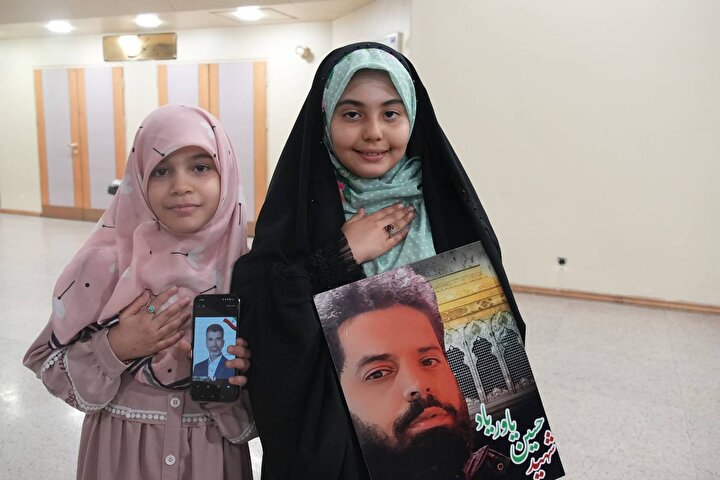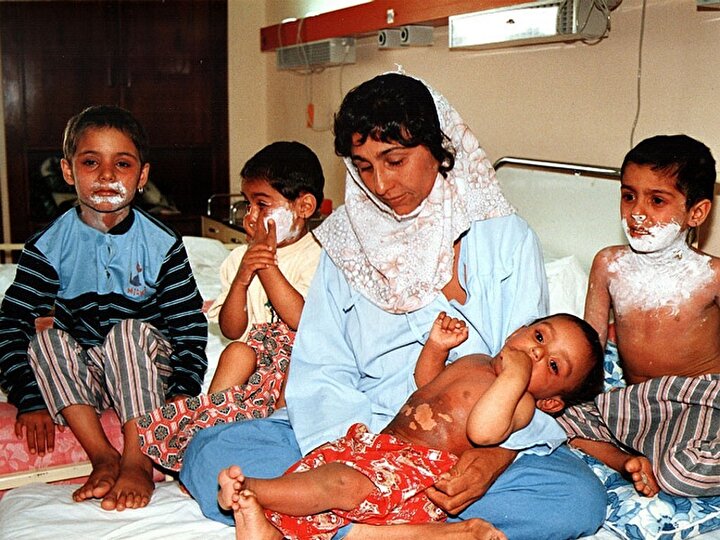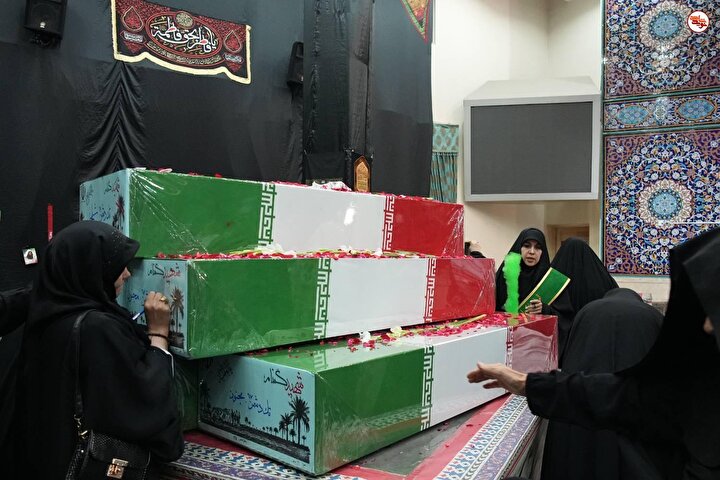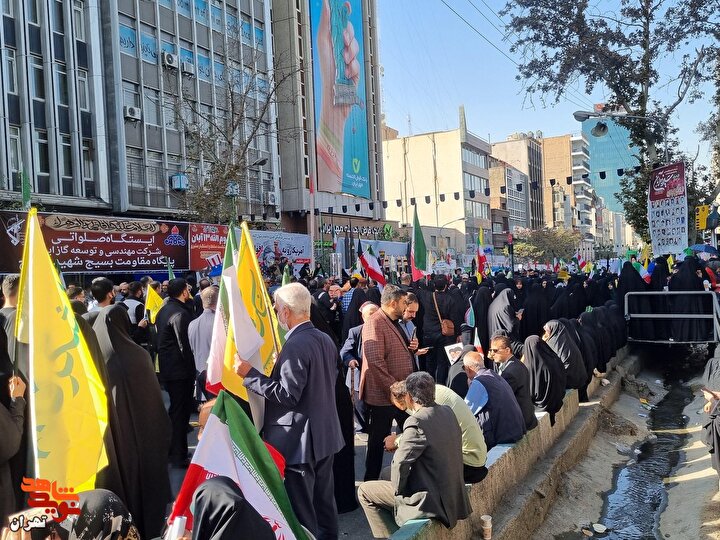
An Interview with the writer of the book ‘War Crimes’

Unfortunately the United Nations showed its indifferences in this field, for example the Secretary General of the United Nations would suspend Iran’s applications for 2 weeks and after two weeks, for sure the consequences and effects of chemical weapons (that Iraqis had deployed against Iranians) would be wiped out or go away. After that it would issue a double-standard or neutralized statement.
According to the reporter of Chemical Weapons Victims Information Base, based on the release of the book ‘War Crimes’ penned by Mohammad Bagher Nikkhah Bahrami in 2000 copies based on the collaboration of the Sacred Defense Documentation and Research Center which has reviewed the Iraqi chemical warfare in its war against Iran, the biological warfare and the brutal usage of chemical weapons have been discussed in this book.
The book has been written in 544 pages which is colorful and with photos along with appendixes. We decided to do an interview with the writer of this strong work, so that we can read it together as follows:
Mohammad Bagher Nikkhah Bahrami pointed out to the newest book which has been released by him and regarding the review of Iraq’s chemical warfare in its war against Iran said: "This book is documentary and based on that there is a comprehensive criticism and at the end a conclusion has been stated that why the United Nations, specially the Security Council had such a stance and if they did not have such a stance, this war would not be prolonged like this.”
He also pointed out to different chapters of the book and he said: "The history of chemical warfare, chemical agents and their usage in the wars, Iraq and its access to chemical weapons, the usage of chemical weapons from the occupation era until the entry of Iranian forces to the Iraqi lands, chemical bombardments during Kheibar military operation and the diplomatic activities of Iran, the increase of Iraq’s chemical warfare during the military operation ‘Badr’ and the political actions of Iran, the huge bombardment of Fav war zone; the climax of Iraq’s chemical warfare attacks against Iran, the repetition of big scale uses of chemical weapons in Shalamcheh, the chemical warfare of Shalamcheh (The Iraqi Baathist’s chemical weapons use against the nation), Iraq’s chemical warfare in the final stage of the war, revealing the secrets, the conclusion of the results of the all chemical weapons attacks against Iran, reviewing all the stances of the international organizations are respectively the titles of the 12 chapters of this book.”
Nikkhah pointed out to this issue that that what books have been used in order to provide the documentaries said: "According to this issue that I had the responsibility of the modern war of Khatam Al-Anbiyah headquarters, I would write down the Iraqi attacks including the chemical warfare along with the procedure, statistics and figures, report of the commandership from the Chemical Weapons Defensive Unit from the brigades and armies. I would struggle so much to document the reports based on different aspects and direct observation that I would have from the military health clinic of our unit. It means the statistic and figures which would cover the war zones of the significant military operations and the places where had been bombarded. Also I would register the type of aircraft, rocket, artillery, the type of weaponries, the type of gases and chemical agents including mustard gas, nerve agents, suffocating, cyanide and… the number of the injured patients, the number of martyrs and also the source of the report. After the war, during 20 years, I collected many more valuable sources that were added to these references. Six board of inspections based on the invitation of the United Nations had been dispatched to the war zone in order to inspect the Iraqi crimes against Iran. They had been sent there to observe the remains of the bombs and by taking some samples of them and the bombs that had not acted in order to do test on them in their laboratories.”
This researcher of the Sacred Defense Era at the continuation of his words said: "The board of inspections which had been sent to Iran on behalf of the United Nations would interview the Iranian chemically injured patients and they would register their chemical injury complications including skin and eye problems. This board of inspection also picked some sampling from the bodies of chemical martyrs in the place where the martyrs’ bodies would be kept. Also they would witness the injured patients; in the form of trip report to Javier Perez de Cuellar, the Secretary General of the United Nations (from January 1, 1982 to December 31, 1991).”
Nikkhah added: "In this report, they would point to different sections. They would consider the military- medical aspects. Also in the chronology of their mission and the type of their visits and report would be handed over to the Secretary General of the United Nations. Also at the end they would present a conclusion. For example they would say: ‘Iraq has used chemical weapons during the military operation ‘Kheibar’ or the capture of Fav.’ And we observed these realities. By presenting reports regarding several cases of their observation to the Secretary General of the United Nations, despite of this the Secretary General needed to have a very strong and firm stance in this field, but we could see, that he had a double-standard view regarding this matter. According to the remarks that he had with the five permanent of the United Nations and they have the rights of veto (Veto is a vocabulary sourced from Latina language and it means I prohibit). Including the United States of America, Russia, France and UK and China themselves would equip Iraq to different types of weapons and they would influence the report and then they would hand it over to the Security Council.”
The commander of Chemical Warfare Defense Unit during the eight year of Sacred Defense Era referred to another part of this book and he continued: "According to the invitation of the Islamic Republic of Iran, the United Nations needed to issue a very strong resolution in this field in order to condemn and punish Iraq due to using chemical warfare and the violation which it had done, requesting the aggressor, making the Iraqi regime to undertake to stop such attacks against Iran, making the countries and western countries, eastern countries and even Asian countries and Africa to undertake not to send raw materials for production of chemical weapons. These contents have been detailed in 443 pages in the context of the abovementioned book were the list of the request of Iran from the United Nations; Unfortunately the United Nations showed its indifferences in this field, for example the Secretary General of United Nations would suspend Iran’s application for 2 weeks and after two weeks, for sure the consequences and effects of chemical weapons (that Iraqis had deployed against Iranians) would be wiped out or go away. After that it would issue a double-standard or neutralized statement.
It means that according to the June 7, 1925 Geneva Protocol, these weapons and poisonous gases had been listed among the prohibited and banned weapons; therefore using them was prohibited. In the Hague and Geneva convention and some of the other announcements, using such weapons are considered as war crimes and in that convention would suggest the both sides in order not to use such weapons.
This kind of behavior by the United Nations for Iraq would be considered as a green light. It would ensure Iraq that in return of the genocide which it would do against Iran by deploying chemical weapons, it would not be punished.
Nikkhah pointed out to this issue and he considered the resolution of the United Nations the same as antidote after the death of Sohrab and he continued: " This negligence of the United Nations would lead to the expansion of such warfare attacks against Iran. From 1987, the 7th year of the war, the Iraqi regime even attacked the civilians areas of Iran. It bombarded the border cities of Iran including those located in Kurdistan province, west Azarbaijan province and Khuzistan. Sardasht, Baneh, Piranshahr, Oshnaviyeh, Marivan, Nusud, Kermanshah, Sare Pole Zahab, Direh, Zeideh, Nudsheh, Paveh and west Gilan, the villages of Khuzistan close to Ahvaz including Howeizeh, Soosangerd etc were the list of the cities and villages that were targeted by Iraq’s chemical warfare. The reason of intensifying these attacks was the lack of sensation and accurate response of the Security Council to this issue. The United Nations totally during the war issued six statements and two resolutions; but none of them were effective and useful. Also in the resolution 612, no effective action was done. The final resolution of the United Nations was the resolution 620 that was issued on August 26, 1988 and it had been coincided with the final chemical rocket that had hit on the ground in the southern war zones.”
Two paragraphs of the abovementioned resolutions pointed out to the request of Iran. It was that the countries must stop exporting raw materials to Iran and Iraq. The resolution that Iran adopted it on July 18, 1988 and Iraqi adopted it on August 6, 1988 and the war between these two countries ended up with a ceasefire; also Iraq had struggled so much to launch the mission which had been given to it by the western countries; also issuing the final resolution could be considered as a antidote after the death of Sohrab.
The writer of the book ‘War Crimes’ pointed out to the chemical complications of these attacks even during the contemporary time and he stipulated: "If this resolution would be issued in 1983 during the military operation ‘Kheibar’ despite of many shortages that it has, it could prevent the expansion of Iraq’s chemical warfare and the increase of the chemical victims and martyrs. Also lesser casualty would be resulted. These losses and negative mental consequences that were left by the usage of such weapons are not comparable with any other wars in the world. The chemical consequences and complications which still exist after many years passing from that event; and its chemically injured patients have to suffer the consequences of chemical weapons so badly. Every few times, some of them get martyred due to the intensity of the injuries which have been left from the Iran-Iraq war era. The genetic consequences left from these weapons after 20 years are still obvious and they indicate the effects of chemical weapons. These complications can appear after a long period of time. Even in the light type of them, they can be developed the in body organ tissues gradually and they can lead to creation of different pulmonary problems and health problems associated to intestine, digestive system, skin, eyes and mental problems. In some cases they lead to occurrence of skin cancer and leukemia. Also the genetic effects can be transferred to the next generation as well. I know many cases that event the children of chemically injured patients have been affected to skin problems.”
Nikkhah acknowledged: in 1975, after 37 years passing from that even out of every 47 children in Vietnam one is paralyzed or deformed and from every four women, one does not have the chance to be a mother. The website Vietnam Association for Victims of Agent Orange/Dioxin (VAVA) is: www.vava.org.vn and you can see the pictures of the victims of Agent Orange and Toxin gases and (Dioxins and furans are a group of toxic chemical) in details.
Mohammad Bagher Nikkhah pointed out to this issue that in this book the existence of some works and complications of chemical weapons have been discussed and he continued: "These weapons and munitions have caused the contamination of the environment. The capital of people and many of the live creatures and fisheries, trees and rivers close to Arvand River, especially during the capture of Fav and Bahmanshir close to Arvand River have been fully damaged. In some places like Shalamcheh, its soil is still contaminated; because in these places, the chemical bombs have been neutralized and the rest of chemical weapons have been buried under soil in a trench and the complications have not been removed yet. In Vietnam also its soil has not been recovered. All of these issues have been reflected in this book.”
Nikkhah in description of the difference of this book with the book ‘Chronology of Iraq’s chemical warfare against Iran during the eight year of the Sacred Defense Era’ said, I have mentioned the date of the events summarily in details and I have used that as well.
In the book the book ‘Chronology of Iraq’s chemical warfare against Iran during the eight year of the Sacred Defense Era’ I have pointed out to the issues mostly in brief form; I have mostly pointed out to the tables that are documentary and obvious and if someone aims to extract some information from these tables and to have a brief view regarding these attacks within an hour, that person can do that. Or in a military operation, the level of bombardments, the number of casualty and victims, the sources and type of weapons can be extracted by paging through the book. The descriptions of these topics have been mentioned in the book ‘War Crimes’. The book the book ‘Chronology of Iraq’s chemical warfare against Iran during the eight year of the Sacred Defense Era’ is a source that the military centers can refer it in order to complete their information in this field. Also they match their contents with this book. They contact and remove the contrasts. In addition, its electronic book for the first time was released in the field of the Sacred Defense. In 30 pages of the book ‘War Crimes’, there are some photos related to the bombardment and chemical rocket attacks from the World War I to Iraq’s chemical warfare against Iran. Also the interviews, memories, articles, information related to chemical warfare, poems and the name of the educational book sources have been mentioned in details in the book the book ‘Chronology of Iraq’s chemical warfare against Iran during the eight year of the Sacred Defense Era’.
He pointed out to this issue that 50 pages of the book ‘War Crimes’ has paid attention to the details and he referred to his main objective and he said: "My main objective for writing this book was drawing the procedure of using weaponries including Iraq’s chemical warfare and their big scales in the dimension of military war zones and non-military places based on the eyewitnesses and narrators of the Iraq’s crimes during the Sacred Defense Era; because the direct responsibility of defense and defense against Iraq’s chemical warfare had been given to me.”
Nikkhah also pointed out to the other goals of writing the book ‘ War Crimes’ and he said: "The writing of this book has been done for some goals including, representation of different dimensions of Iraq’s crimes or Iraq’s genocide and genocide against humanity according to the Geneva and the Hague convention.”
He said: "Some different activities which were done inside and outside of Iran in accordance to the political diplomacy. Also the Media activities that were done in this field took place in order to reveal the crimes that Iraq did against Iran by sending Iranian injured patients to foreign countries in order to show that what crimes were being committed against Iran. Also the ambassadors and political delegates and the military authorities would visit the crimes works to describe the different dimensions and their activities.”
He also notified: "The indirect supports of the Security Council to Iraq took place by imposing barriers and doing just judgment to the audiences for the purpose of public opinion in order to reach the negligence and the green light of the United Nations to Iraq.”
Nikkhah pointed out to this matter that he has aimed to write this book to show the innocence of Iran to the public opinion and he stipulated: "More than 26 countries and about 460 foreign companies including private, governmental and multinational companies were the supporters of the Iraqi regime. In this book, the names of each of them, their activities and aids to Iraq have been mentioned. I have combined them in a paragraph in order to make the reader to understand that we were alone in this war.”
He said: "At the end, I have assessed the general barriers of the United Nations and the Security Council and its other organs including the Red Cross, the Organization for the Prohibition of Chemical Weapons and the Organization of the International Zones, Arab Unions, the Security Council, the United Nations itself, the General Assembly of Conference, the Non-Aligned Movement which comprises 120 states, the physicians without borders and whatever is related to the United Nations.”
This researcher and writer of the Sacred Defense Era in another part of his words pointed out to this issue that there are some documentary photos in the final part of the book and he said: "In the photos section, there are some three-dimensional colorful charts by listing some pyramid and column statistics. For example in the table that shows the number of attacks, the percentage of attacks has been also exhibited too. They have been highlighted with tangible colors. In this table it is shown that Iraq deployed chemical weapons against Iran in 582 cases. For example it has been specified that in each zone, in each military operations in a total figure has been mentioned that how many attacks with what equipments and what chemical agents and how much the level of casualty has been.”
These representations have been determined in a curved line. Also the statistic of martyrs and chemically injured patients has been listed as well. For example in Iran there are 100.000 chemically injured patients and more than 250.000 persons were exposed to lighter level of chemical weapons and 10.000 chemical martyrs. Also in Halabja and Iraqi Kurdistan there are 7250 martyrs and more than 27000 persons were exposed to chemical weapons and about 200.000 persons suffer light chemical weapons complications.”
The interested persons can obtain the book ‘War Crimes’ by contacting the Sacred Defense Documentation Center by the following phone number: 00982166481531
It should be noted that Mohammad Bagher Nikkhah Bahrami was born in 1952 in one of the villages close to Zanjan city. He continued his education in Tehran city until 1978. After that he went to the military service and he got familiar with the political atmosphere of the time when he went to the university. Mohammad Bagher Nikkhah Bahrami has written down the realities related to the revolution era based on what he has witnessed and he continued this procedure for the significant events after the Islamic Revolution victory as well. Nikkhah is the writer of the book ‘Chronology of Iraq’s chemical warfare against Iran during the eight year of the Sacred Defense Era’, ‘Machine of Morale’ (Consisting of the memories of Mohammad Bagher Nikkhah, the famous face of the propaganda and war) and ‘Bank of Inamorata’ (compiling the memories of artists and athletes during their trips to southern war zones based on the collaboration of Mr. Asna’ashari) is one of the authorities and senior military ranking, the propaganda of the southern war zones and Karbala and the commander of Chemical Warfare Defense Unit during the eight year war of the Sacred Defense Era hat different posts of the war zone. Some of these posts were associated to the Chemical Defense Unit, discovering and neutralizing the chemical weapons that had been deployed by the Iraqi Baathist regime. Also some of the texts which have been presented by him express the realities and experiences of the Iranian war veterans in the field of sacrifice and martyrdom. During the recent years, he has written many books and articles related to the Iraq’s chemical warfare against Iran.
The End



